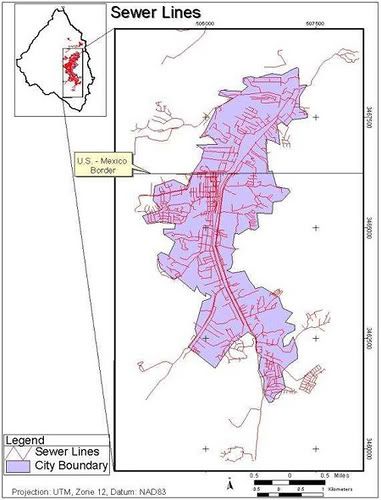If you can't get over the wall, go under it.
When I was a kid of about seven or eight, one of my favorite movies was "The Great Escape," the true story of a resourceful group of allied servicemen held in a German POW camp who manage to outwit their captors and dig an escape tunnel right under the noses of their keepers. With its mix of suspense and action it seemed to my young mind to be a great story of bravery and imagination…the kind of movie young boys have found fascinating to this day.
Yet, there is something about the movie, perhaps the amazing ingenuity born of desperation, that comes back to haunt me when I think about the current situation at the border. When I hear the talk of increased border security and building hundreds of miles of walls, all that comes to mind are the scenes of allied POWs moving tons of earth with homemade tools made from kitchen utensils. If they couldn't get over the wall that held them in, they'd just go under it.
Apparently, according to the blog, Subtopia, that's exactly what's going on daily all along the border from El Paso to San Diego
tags: immigration, border wall , tunnel, border security
In one of the most comprehensive stories yet written about the topic, "Orwellian Wormholes" looks at the thousands of miles of underground sewers, storm drains, flood control tunnels and culverts that lace the border between Mexico and the US, and more importantly how this subterranean world has become a virtual superhighway for smugglers, drug-runners, coyotes, and undocumented immigrants.
With the estimated cost of the 850 mile long border fence authorized by the President back in October for $1.2 billion now looking closer to $60 billion, this article raises serious questions about the effectiveness of wall-building when, beneath those walls, tunnels and storm drains cris-cross an unprotected border.
And so, welcome to the brave new world of cross-border tunnel migration and militarization – and, what could be the glimpse of a future (sub)urban world as more nation states wall off their borders from the increasing flows of global migration.
…
… “Illegal immigrants have breached drainage systems all the way along the border, from El Paso to San Diego. Most of them are of the claustrophobic crawl-through variety that prevents large-scale incursions”, or “gopher holes” as the military calls them. The Nogales tunnels, however, which are subsets of entire watershed infrastructure, are - by comparison, he says – borderzone superhighways.
Once open waterways, today they stretch for miles under the traffic-clogged downtown streets of both cities, zigzagging roughly parallel to each other. […] In the smaller one, called the Morley Tunnel, an ankle-high stream of raw sewage and chemical runoff from factories in Mexico usually flows. The neighboring Grand Tunnel is up to 15 feet high and wide enough to fit a Humvee
…
Essentially, the infrastructure has been left an exhausted corpse of overgrown concrete appendages and flogged lungs that today becomes a kind of mysteriously populated anti-city lurking below the real city above. It’s partly a thriving subterranean landscape with thousands of people traversing and living and conducting their own brand of commerce, but it’s also partly a massive industrial grave stewing with noxious hazards and quiet anonymous deaths. Maybe these giant tunnel-bored metacarpals fingering the earth will one day come to be revealed as the U.S./Mexico’s border equivalent of the Indian ghats infamously situated along the Ganges river - water levels raising and lowering while more and more borderzone settlements take to the underground in light of the increased immigration surveillance cementing itself at ground level.  The article goes on to describe the tunnels and infrastructure with detailed maps, surveys, photos, and testimony. It really is an amazing story and a must-read for anyone interested in immigration, immigration reform or border security. It sheds new light on the whole concept of trying to seal the borders as the sole method of immigration reform.
The article goes on to describe the tunnels and infrastructure with detailed maps, surveys, photos, and testimony. It really is an amazing story and a must-read for anyone interested in immigration, immigration reform or border security. It sheds new light on the whole concept of trying to seal the borders as the sole method of immigration reform.
A common criticism of the effectiveness of any border wall has been that if you build a twenty foot wall, someone will make a twenty-one foot ladder…..after reading this article one realizes that the ladder is the least of the worries. It's the thousands of miles of existing subterranean infrastructure, augmented by new tunnels and passageways dug everyday, that make the wall such an ineffective means of border security...and immigration policy.

































2 comments:
haha. do you realize how costly and time-consuming it is to build underground tunnels? no average border crosser would be able to make large enough tunnels for themselves, let alone others. if they had the money and tools to build large tunnels, they probably wouldn't be coming here illegally in the first place. if the border fence was built, they would rely on smugglers to build tunnels, but by then the cost of making large tunnels, and the significant increase in demand, would raise the price of smuggling to large numbers, much more than most lower-class mexicans could afford. migrant smuggling might spike a bit, but (much) more so drug smuggling, because there is more profit in that.
If you read the linked material you would know that the tunnel infrastucture is already in place...no one has to dig it...its already there.
Post a Comment